Financial Stability Review – April 2018 2. Household and Business Finances
Macro-financial risks emanating from the household sector remain, given the high level of household debt and strong growth of riskier lending in previous years. However, the build-up of risks has abated somewhat of late, in part reflecting the Australian Prudential Regulation Authority's (APRA's) prudential measures in the residential mortgage market. Continuing a trend that has been evident for some time, standards for new lending to households have improved further, with a lower share of new loans having riskier characteristics, such as interest-only (IO) terms and/or high loan-to-valuation ratios (LVRs). Nationally, housing market conditions have eased, with prices notably falling in Sydney.
Overall, most indicators suggest that the incidence of household financial stress is not widespread, although some households could be tested were unemployment to increase. Existing housing loans, including those written under earlier weaker standards, continue to perform well given good economic conditions in most of the country. In addition, borrowers coming to the expiry of an IO payment period face a sizeable increase in their scheduled payments if they transition to principal and interest (P&I) payments. While most of these borrowers appear well placed to handle this change, liaison with banks suggests a small minority will face difficulty affording the higher scheduled payments.
In apartment markets, the peak of the large pipeline of new additions in Melbourne and Brisbane looks to have passed, and to date has been absorbed without significant disruption.
Indeed vacancy rates are currently declining and falls in apartment prices have been modest in these cities. Settlement failures have been concentrated in lower-quality developments and there have been some reports of settlement delays, predominantly in Brisbane. Where settlement failure has occurred, developers appear to have largely been able to resell the apartment to another buyer, although some developers may be delaying selling apartments where there is weak demand. While the growth of the total housing stock does not appear excessive relative to overall population growth, ongoing strong growth of the apartment stock over the next year or so, especially in Brisbane, could yet weigh further on apartment market conditions there.
In non-residential commercial property markets, prices continue to increase strongly. This is particularly evident in the Sydney and Melbourne office property markets. Price growth has been underpinned by strong demand and some demolitions and conversions of existing office buildings to apartments, and it continues to exceed the rate of growth in rents, thereby further lowering yields. One risk is that, if global bond yields were to rise further, these low yields may not be sustainable as investors seek more attractive returns. In contrast to Sydney and Melbourne, conditions in the Perth and Brisbane office markets remain relatively weak.
In other parts of the business sector, conditions are generally favourable. Corporate profitability remains high and gearing low relative to the past. Business failure rates in the mining states have stabilised after increasing, as the drag from mining investment has eased. The retail sector's corporate insolvency rate also remains low, notwithstanding some recent high-profile failures amid a challenging competitive environment for some segments.
Household Sector
Household financial position
The ratio of total household debt to income has increased by almost 30 percentage points over the past five years to almost 190 per cent, after having been broadly unchanged for close to a decade (Graph 2.1).[1] Australia's household debt-to-income ratio is high relative to many other advanced economies, including some that have also continued to see strong growth in household lending in the post-crisis period, such as Canada, New Zealand and Sweden. Household debt in these economies is notably higher than in those that were more affected by the financial crisis and experienced deleveraging, including Spain, the United Kingdom and the United States. While Australia's high level of household indebtedness increases the risk that some households might experience financial stress in the event of a negative shock, most indicators of aggregate household financial stress currently remain fairly low (notwithstanding some areas of concern, particularly in mining regions). In addition, total household mortgage debt repayments as a share of income have been broadly steady for several years (Graph 2.2).
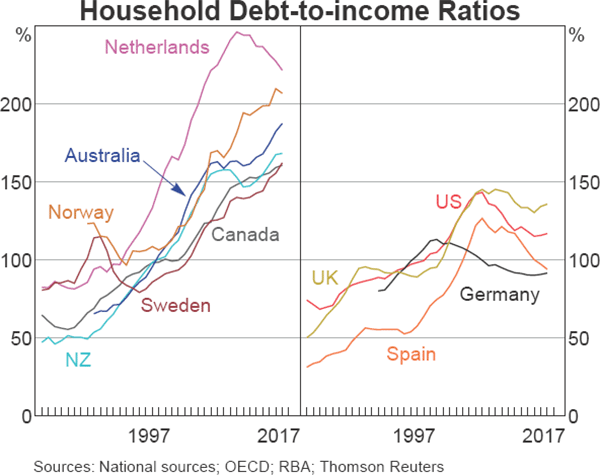
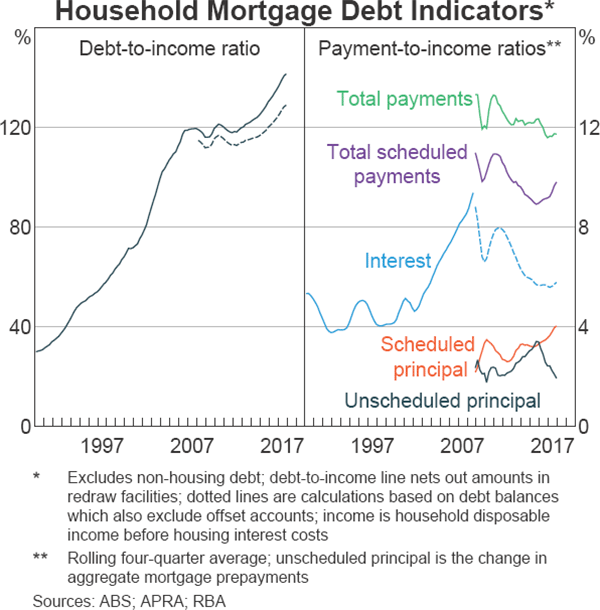
As outlined below, regulatory measures and improvements in lending standards have contributed to a significant improvement in the risk profile of new lending over the past couple of years, and so stemmed the deterioration in the resilience of household balance sheets. However, the risk from the stock of existing loans remains. Overall, while rising a bit recently, non-performing housing loans remain a low share of the outstanding stock of loans, indicating that the overall quality of outstanding housing debt remains generally high (Graph 2.3). However, non-performing loans in states with more mining activity have increased, reflecting increases in unemployment and weak income growth in these regions. In other states, the non-performing share of housing loans has been steady, indicating the potential risks associated with the quality of earlier lending have not materialised to date. Household net wealth also continues to rise, although the rate of increase has slowed more recently given the moderation in housing price growth.
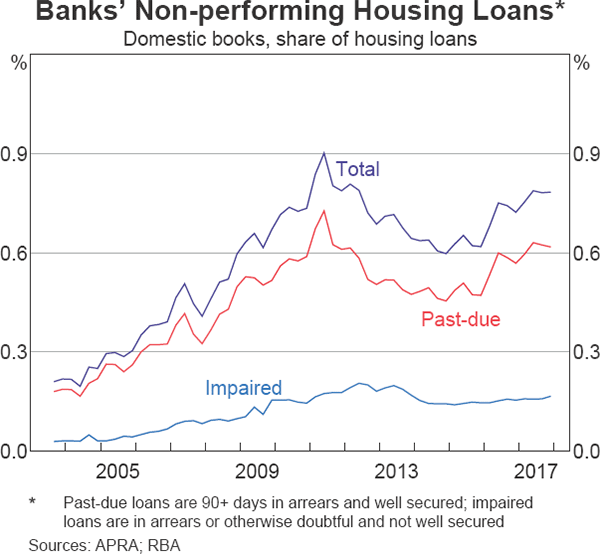
Debt servicing ratios have increased, in part because of loan switching from IO to amortising products in response to the prudential measures in 2017. To date, households have partly accommodated these increases in payments by lowering their voluntary prepayments of principal and have been aided by the low interest rate environment. Consistent with this, comprehensive survey measures continue to suggest that, in aggregate, the incidence of household stress is relatively low by recent historical standards. Data from the Household Income and Labour Dynamics in Australia (HILDA) survey indicate that in 2016 fewer than 5 per cent of households had required mortgage payments greater than 50 per cent of their disposable income, with the majority of these households in the lowest income quintile.
The HILDA survey and the 2015/16 Household Expenditure Survey also indicate that the share of households experiencing financial stress has been the lowest since at least the early 2000s (Graph 2.4). While the overall level of stress among mortgaged households remains relatively low, there are some pockets of financial stress. In particular, the incidence of household financial stress is noticeably higher in Western Australia than in other parts of the country, with the rate of personal administrations rising further over 2017 and applications for property possessions increasing over recent years. Indeed, while there has been a rise in non-performing personal credit, this does not appear indicative of a broader deterioration in household finances (see ‘Box B: Recent Trends in Personal Credit’).
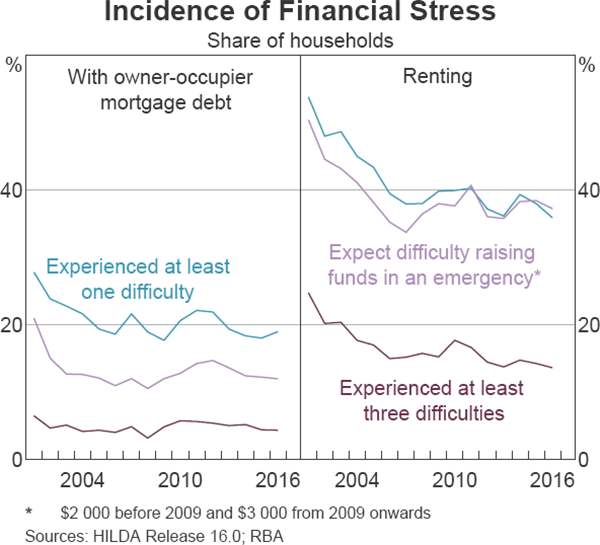
Prepayments enable households to build a financial buffer to cushion mortgage rate rises or income falls. Aggregate mortgage prepayments – balances in offset accounts and redraw facilities – are around 18 per cent of outstanding loan balances, or over 2½ years of scheduled repayments at current interest rates (Graph 2.5, left panel). These aggregates, however, mask substantial variation; about one-third of mortgages have less than one month's prepayments (Graph 2.5, right panel). Of these, not all are vulnerable given some borrowers may accumulate savings outside of their mortgage, including those with fixed-rate mortgages (which restrict the ability to make prepayments) and investors (who have incentives not to pay down tax-deductible debt). Some borrowers with new mortgages are yet to accumulate prepayments and so would be vulnerable to income falls. Liaison with the banks suggests that there is a small share of borrowers who have not accumulated prepayments despite having had their loan for some time and may have little margin for unexpected increases in living expenses or income falls.
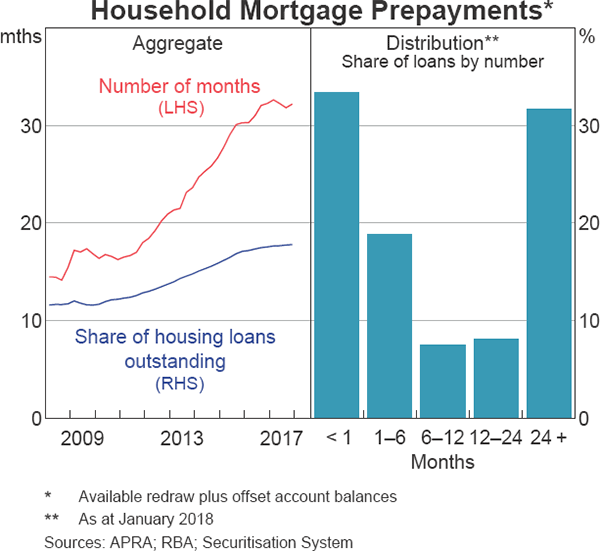
One area of potential concern is for borrowers at the end of their current IO period. Much of the large stock of IO loans are due to convert to P&I loans between 2018 and 2021, with loans with expiring IO periods estimated to average around $120 billion per year or, in total, around 30 per cent of the current stock of outstanding mortgage credit. The step-up in mortgage payments when the IO period ends can be in the range of 30 to 40 per cent, even after factoring in the typically lower interest rates charged on P&I loans.
However, a number of factors suggest that any resulting increase in financial stress should not be widespread. Most borrowers should be able to afford the step-up in mortgage repayments because many have accumulated substantial prepayments, and the serviceability assessments used to write IO loans incorporate a range of buffers, including those that factor in potential future interest rate increases and those that directly account for the step-up in payments at the end of the IO period. Moreover, these buffers have increased in recent years. In addition to raising the interest rate buffer, APRA tightened its loan serviceability standards for IO loans in late 2014, requiring banks to conduct serviceability assessments for new loans based on the required repayments over the residual P&I period of the loan that follows the IO period. Prior to this, some banks were conducting these assessments assuming P&I repayments were made over the entire life of the loan (including the IO period), which in the Australian Securities and Investments Commission's (ASIC's) view was not consistent with responsible lending requirements. As a result, eight lenders have agreed to provide remediation to borrowers that face financial stress as a direct result of past poor IO lending practices. However, to date, only a small number of borrowers have been identified as being eligible for such remediation action. Some borrowers have voluntarily switched to P&I repayments early to avoid the new higher interest rates on IO loans, and these borrowers appear well placed to handle the higher repayments.
Some IO borrowers may be able to delay or reduce the step-up in repayments. Depending on personal circumstances some may be eligible to extend the IO period on their existing loan or refinance into a new IO loan or a new P&I loan with a longer residual loan term. The share of borrowers who cannot afford higher P&I repayments and are not eligible to alleviate their situation by refinancing is thought to be small. In addition, borrowers who are in this situation as a result of past poor lending practices may be eligible for remediation from lenders. Most would be expected to have positive equity given substantial housing price growth in many parts of the country over recent years and hence would at least have the option to sell the property if they experienced financial stress from the increase in repayments. The most vulnerable borrowers would likely be owner-occupiers that still have a high LVR and who might find it more difficult to refinance or resolve their situation by selling the property.
Housing and mortgage markets
A key contributor to the abatement of new risks in mortgage and housing markets has been the regulatory measures to improve the quality of new lending. For several years, APRA has also taken a number of steps to improve lending standards by authorised deposit-taking institutions (ADIs), while ASIC has stepped up its monitoring and enforcement of lender compliance with responsible lending requirements. The types of lending that potentially posed the greatest risk to the macro-financial system have been specifically targeted since the end of 2014, including a 10 per cent benchmark for the growth of ADIs' investor lending and a 30 per cent cap on the flow of their new IO loans.
Collectively these measures have worked to moderate the risks that had been emerging in household mortgage debt. The share of approvals that were for new IO loans fell to around 16 per cent in the December quarter, the lowest share in over 10 years and well below both the 30 per cent benchmark and its peak of 44 per cent in late 2014 (Graph 2.6).
These measures have contributed to a significant moderation in new investor lending across all states (Graph 2.7). However, given the very sharp fall in new IO and investor lending, some banks have indicated that they have room to grow this type of lending and there have been some targeted reductions in interest rates for particular segments. Lending at high LVRs (greater than 90 per cent) also remains at low levels by recent standards.
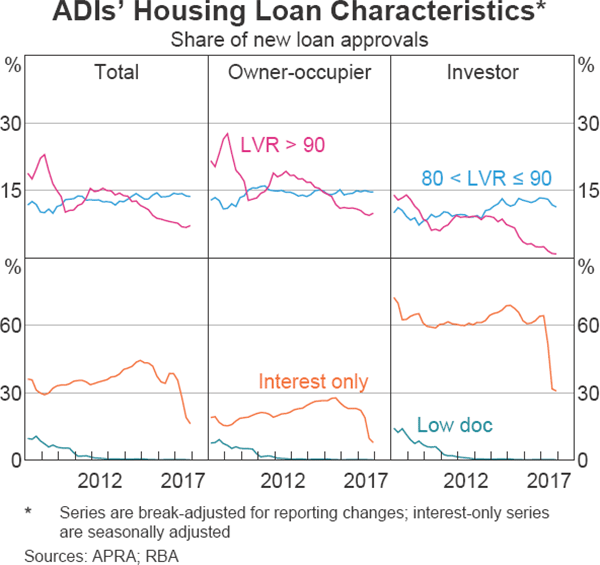
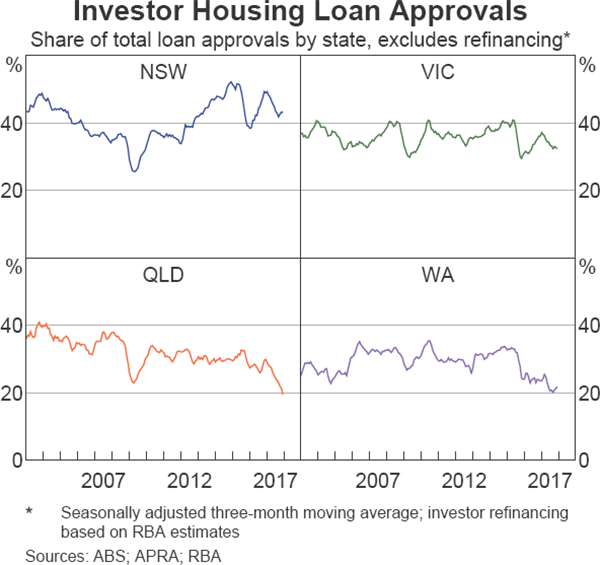
Lenders have used interest rate differentials to alter the composition of their lending in order to comply with APRA's expectations, in combination with some tightening of LVR restrictions. At present, new IO investment loans are priced at an average premium of around 85 basis points above new owner-occupier P&I loans. According to bank liaison, lenders are competing strongly for owner-occupier P&I borrowers that also have low LVRs, which has been reflected in lower interest rates for this group. There has also been a pick-up in lending to first home buyers as demand from investors has eased. The slowing in investor credit was initially partly offset by rising owner-occupier credit growth, although more recently this too has also slowed.
The easing in housing market conditions reflects a number of factors. In addition to APRA's regulatory measures, earlier increases in interest rates for some types of loans, increased housing supply, and some reduction in demand from foreign buyers have contributed. However, a number of other factors have continued to support the market, including the ongoing low interest rate environment and population growth, particularly in Melbourne.
The easing has been most evident in Sydney, where housing prices have started to decline, although price growth has also slowed noticeably in Melbourne (Graph 2.8). In both cities, the decline in price growth has been more pronounced for detached houses and more expensive properties. This suggests that the regulatory measures, which have had more impact on investors (who tend to purchase apartments and less expensive properties), were not the only drivers of the slowing housing market conditions. In a further sign of easing conditions, auction clearance rates are well below their decade average in Sydney and have also been declining in Melbourne, although auction volumes remain high. In Brisbane, apartment prices have been relatively stable following price falls in 2016 and 2017. Falls in rental income remain a risk for investors, particularly in Perth and inner-city areas of Brisbane. The housing market in Perth remains weak. While the pace of price and rent declines has slowed, the vacancy rate remains elevated (Graph 2.9).
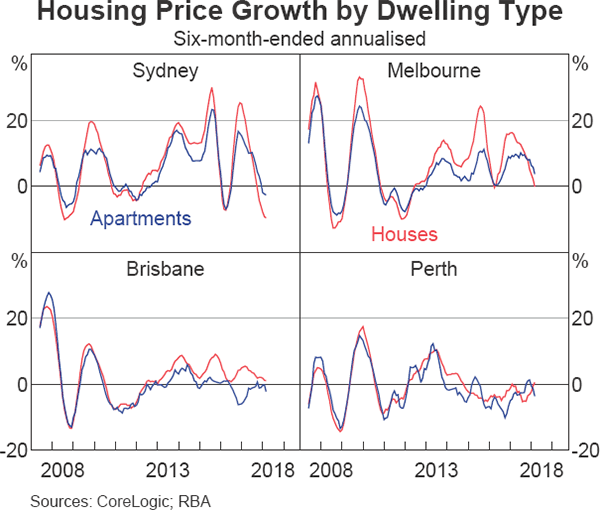

Commercial Property
Residential development
The potential risks posed by the large pipeline of apartment construction in Sydney and pockets of inner-city Melbourne and Brisbane have not materialised in a significant manner, at least to date (Graph 2.10). In Melbourne and Brisbane, the flow of new additions has peaked and, so far, been absorbed with little disruption to apartment markets, with vacancy rates steady or declining, rents steady or rising, and apartment prices generally only falling modestly (Graph 2.11). However, risks remain, with a substantial number of new apartments yet to be completed and some pockets of inner-city Brisbane already experiencing more pronounced price declines. The increased share of new housing that is high density, and has a longer planning and development phase, raises the risk of amplified housing cycles as increased supply may not be well timed to match changes in demand.
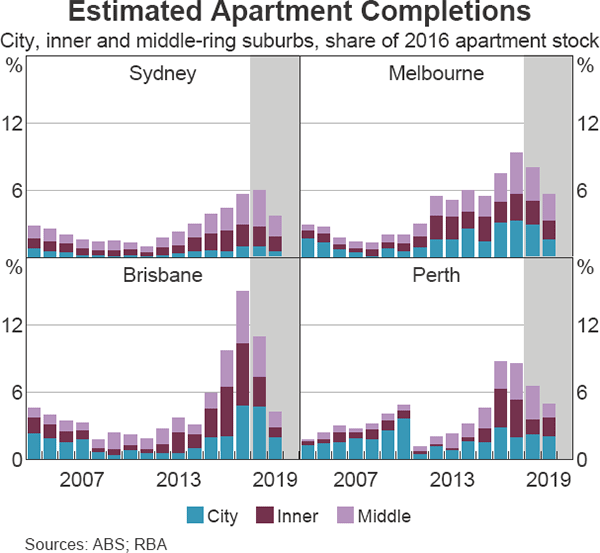
According to liaison with industry, valuations at settlement in some locations have been below the purchase price, in particular for some lower-quality apartments in Brisbane. There have also been reports of increased settlement failure rates and longer settlement times for these types of developments, due mainly to tighter financing conditions for foreign buyers. Stricter lending standards for borrowers relying on foreign income have led to some buyers experiencing difficulties raising funds domestically, while tightened Chinese capital controls have made it harder for the many buyers from that country to expatriate funds. Liaison suggests that developers have generally been able to find other buyers at broadly similar prices to those previously contracted, although it is possible that some developers are holding excess stock on their books and so have increased their exposure to losses if prices fall materially. In contrast, for higher-quality apartments, which tend to mostly be marketed to owner-occupiers and have better locations and amenities, buyer demand has remained strong and settlement valuations are generally around the purchase price.

Developers' access to bank finance remains tighter than a few years ago, particularly for projects in areas where a large volume of new supply has already recently come on line. However, liaison suggests that non-banks have increased their lending to this sector significantly, including for lower-quality projects. Nevertheless, building approvals for new projects in Brisbane remain low. In Perth, liaison suggests that demand for new dwellings has stabilised, although developer margins are very thin. Several small-to-medium-sized builders have filed for bankruptcy in Perth and Brisbane and one large commercial builder in Perth has ceased operations. Property market analysts anticipate more failures in coming months as competition among builders leads to lower margins, partly to keep their workforce continuously employed.
Other commercial property
Ongoing strong demand for commercial property has seen further falls in yields as growth in prices continues to outpace rents (Graph 2.12). To some extent the low yields reflect the low global interest rate environment. However, in liaison, banks have expressed concern over the particularly modest returns implied by some recent transaction prices (Graph 2.13). If these valuations are not sustained, say because of a further increase in global interest rates leading to a reallocation of investor portfolios away from commercial property, highly leveraged borrowers could be vulnerable to breaching their LVR covenants on bank debt, which could potentially trigger property sales and large price declines.
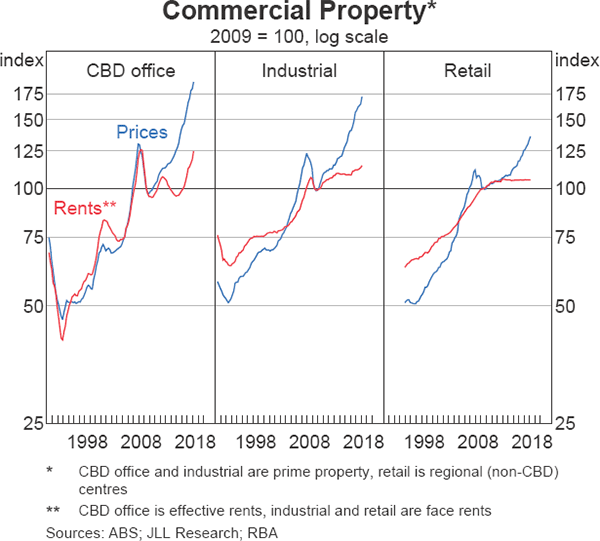
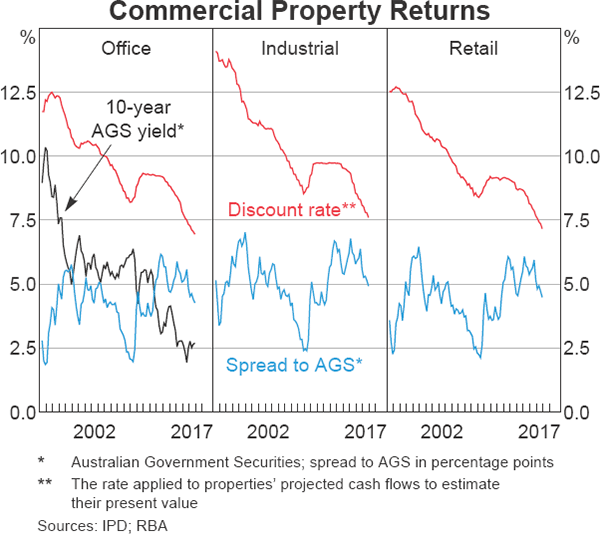
Conditions in commercial property markets differ significantly by state and property type. Investor demand remains strongest in the Sydney and Melbourne office markets, where limited net increased supply over recent years and robust tenant demand have driven vacancy rates to near historic lows. Industry liaison suggests that smaller firms are becoming more important for tenant demand in offices. The recent strength in the prices of office buildings has elicited a strong supply response from developers, particularly in inner-city Melbourne, where additions to the stock of office floor space are expected to increase strongly over the coming years. If these new additions were to be completed in a deteriorating market, they may precipitate price declines, particularly for existing, lower-quality stock. In Brisbane, Perth and Adelaide, elevated office vacancy rates and falling rents have seen tenants relocate into better quality space in the commercial business district (CBD). This continues to place pressure on second-grade and non-CBD markets, where the outlook remains weak (Graph 2.14).
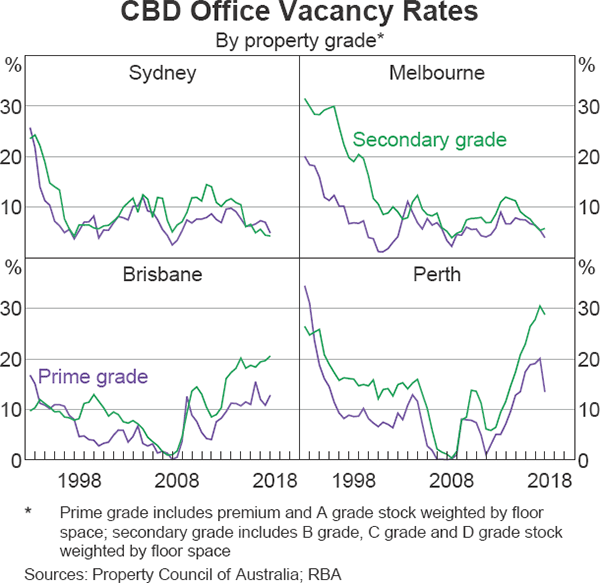
Conditions in retail property markets continue to be subdued. Rents have been flat amid headwinds to retailers' margins that are associated with strong competition from online and new entrants. Banks have nevertheless continued to fund projects which increase the entertainment and hospitality services provided by existing shopping centres (to differentiate these retail offerings from online shopping) (Graph 2.15). At the same time, they view the outlook for some older and less well-located retail properties as weak due to lower tenant demand.
Australian-owned banks have tightened their lending criteria for commercial property following APRA's thematic review of the industry in 2016 and they have slowed the growth in their exposures (Graph 2.16). Notably, their responses included a mix of lowering maximum LVRs, raising minimum interest coverage ratios and capping the percentage of foreign presales in residential developments. Deal flow data show a reduction in average LVRs, particularly for residential development deals, over 2017. Australian-owned banks' commercial property exposures are little changed over the past two years while the exposures of foreign banks, especially those headquartered in Asia, have continued to grow (Graph 2.16).
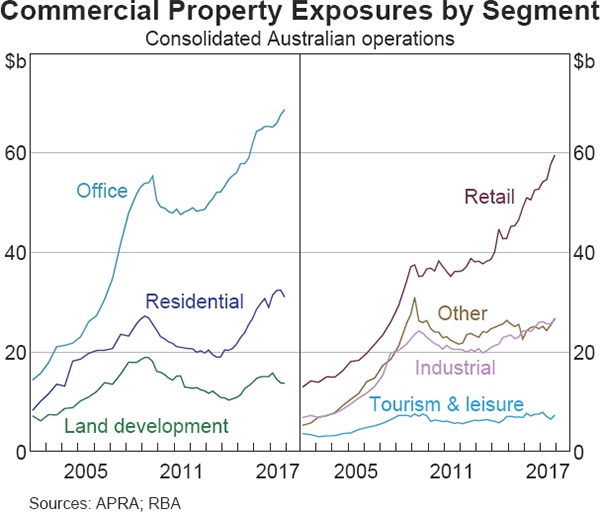
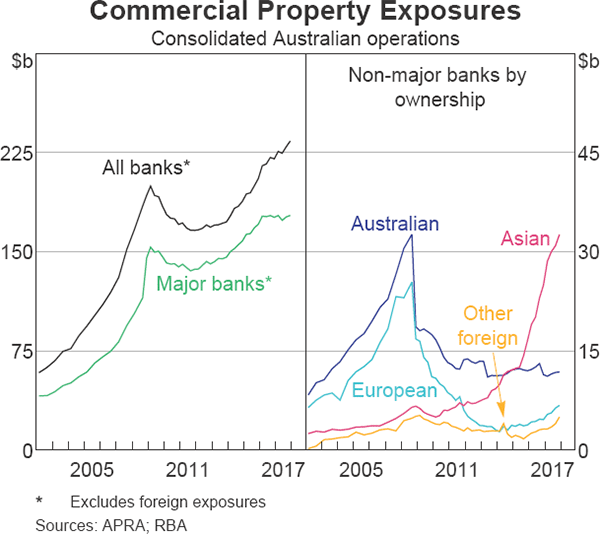
Other Business Sectors
Businesses' finances generally remain in good shape, supported by the ongoing improvement in overall economic conditions and low interest rates. Aggregate earnings of listed corporations continued to rise across most industries over the second half of 2017. The gearing ratio of listed corporations remains below its historical average and a market-based measure of default risk indicates that listed companies remain in generally good financial health (Graph 2.17). The business sector is well placed to service its debt; businesses' debt-servicing ratios declined over the second half of 2017, supported by a pick-up in profits (Graph 2.18).

Conditions in the resources sector have continued to improve. Earnings of resource-related corporations increased further over the second half of 2017, supported by higher commodity prices, increased exports and ongoing cost reductions. Many listed resource-related corporations have used their rising profits to reduce debt further, with the gearing ratio of resource-related corporations continuing to decline. However, the earnings of mining services companies have maintained their downward trend reflecting the focus on cost reductions by resource producers. In the mining states, business failure rates have stabilised, as the drag from declining mining investment has eased.
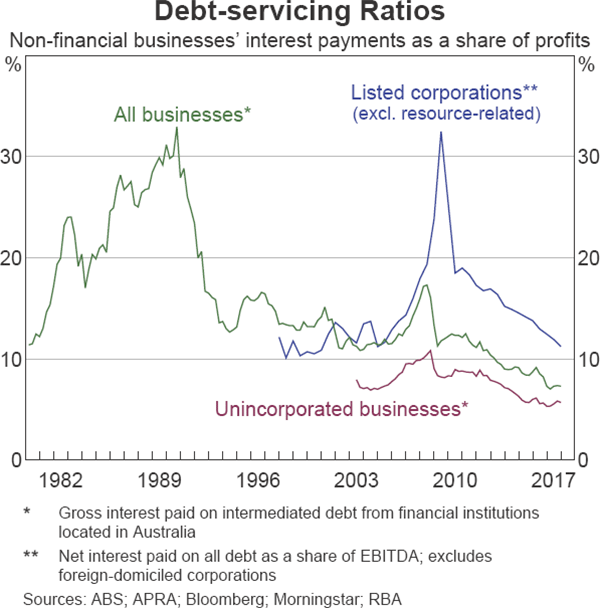
Despite an overall improvement in business conditions, the discretionary retail sector (including clothing, apparel and footwear and department stores) is facing challenges. These businesses are experiencing strong competition from online and international retailers and liaison indicates that retailers are investing in technology to increase efficiency. Although there have been some recent high-profile failures, the retail sector's corporate insolvency rate remains low.
Footnote
The measure of household debt in Graph 2.1 includes non-housing related debt, as well as debt owed to the non-financial sector and to non-resident lenders. The debt-to-income measure in Graph 2.2 is narrower in that it includes only mortgage debt to the Australian financial sector. [1]